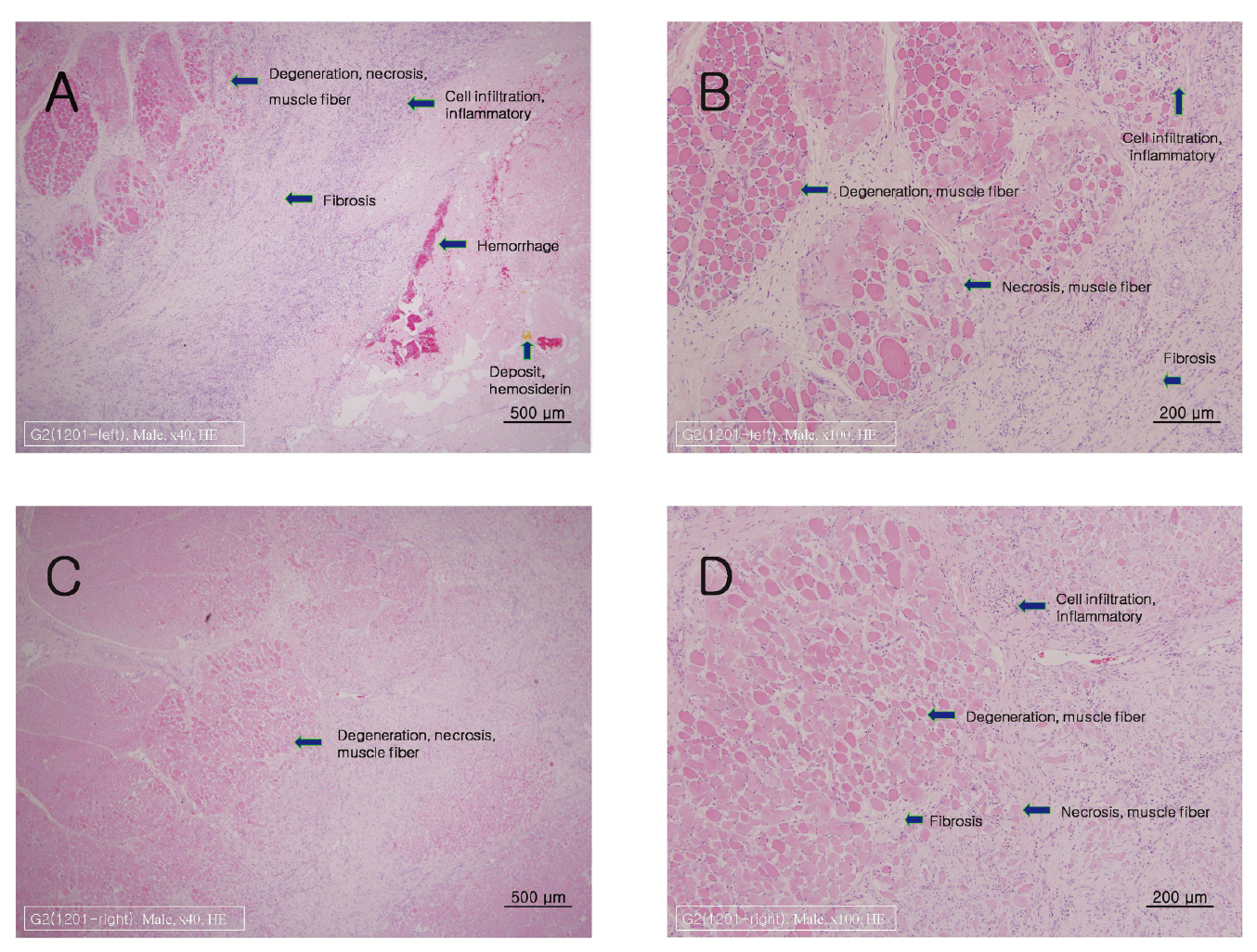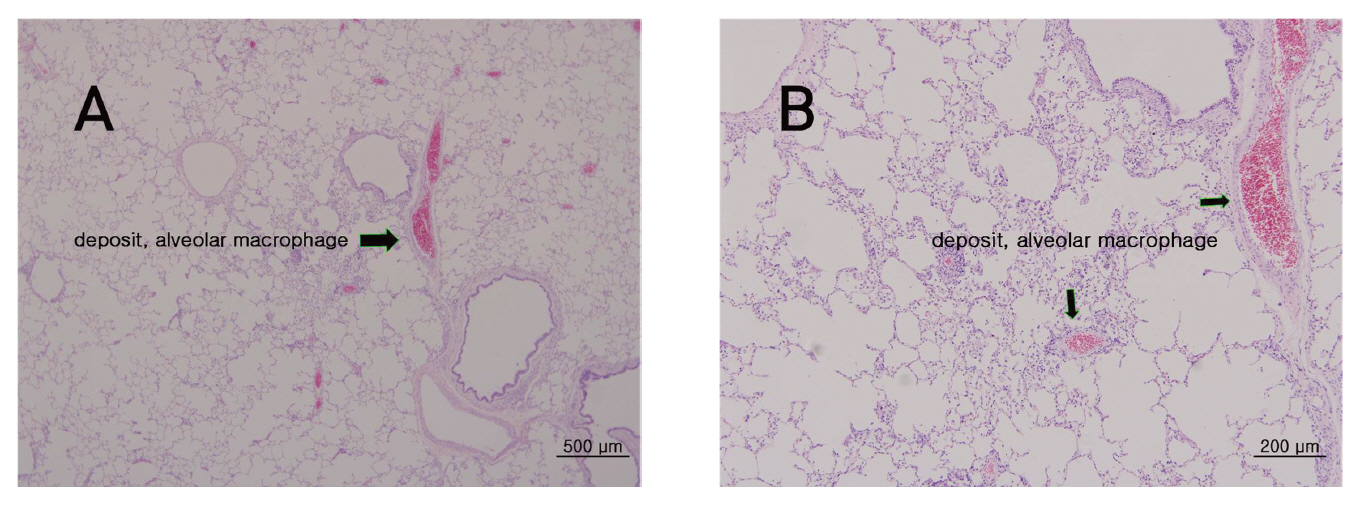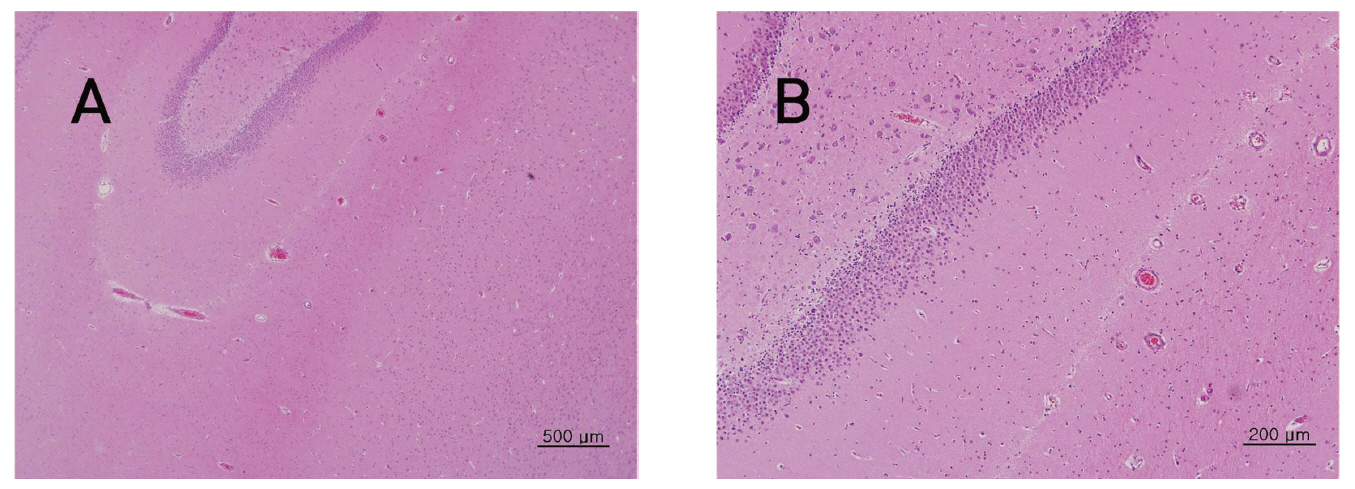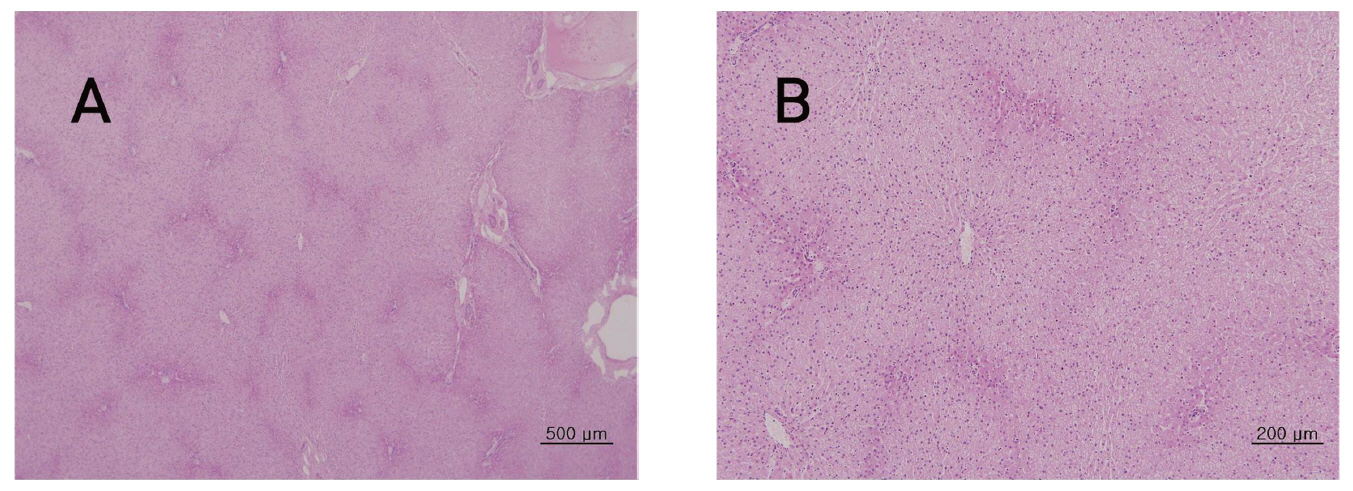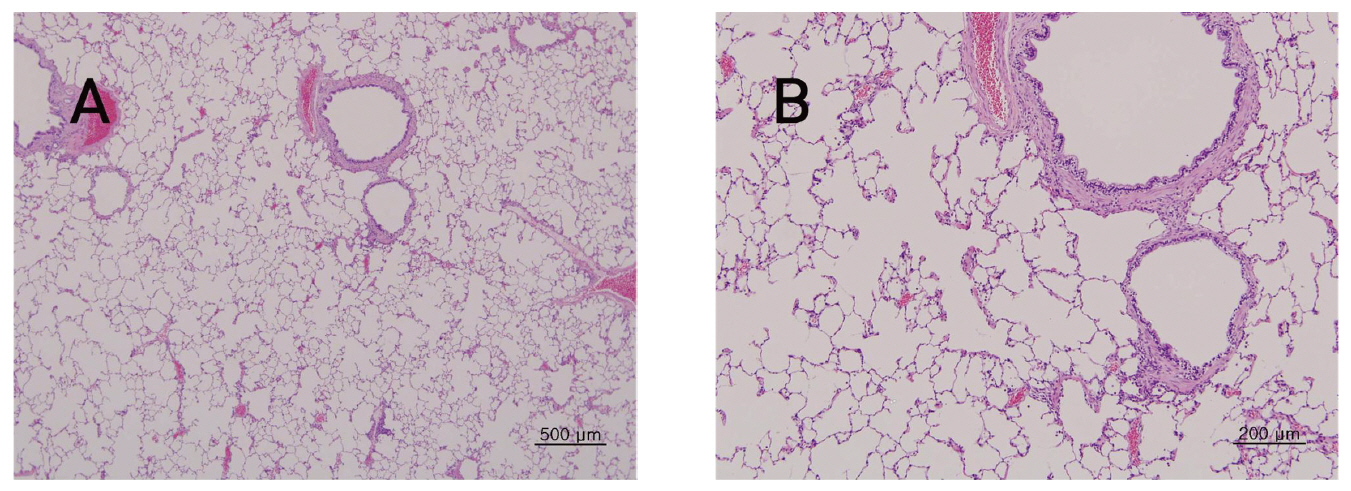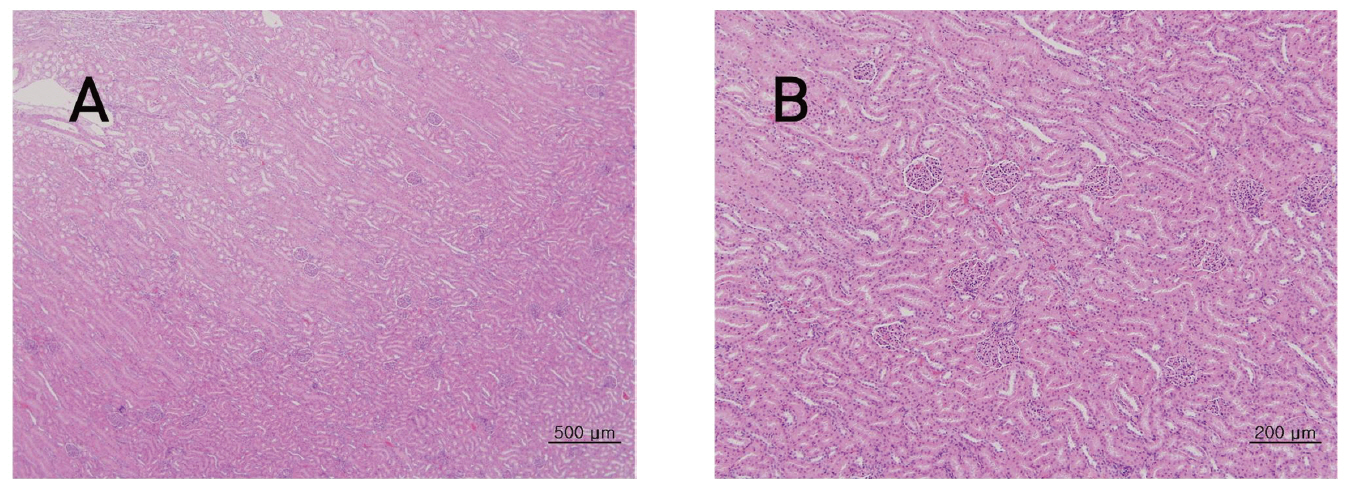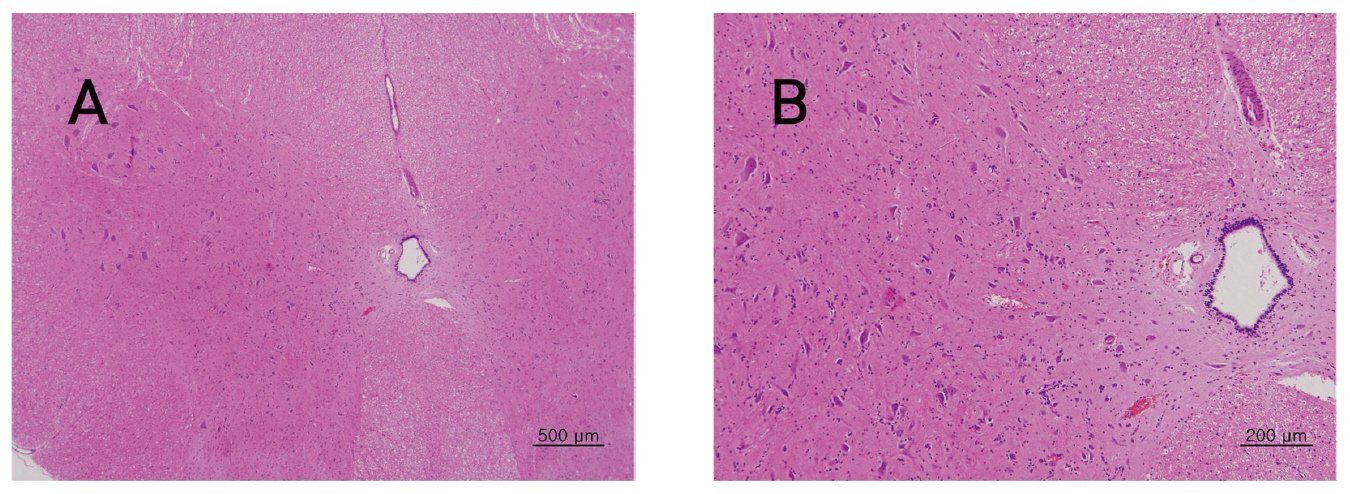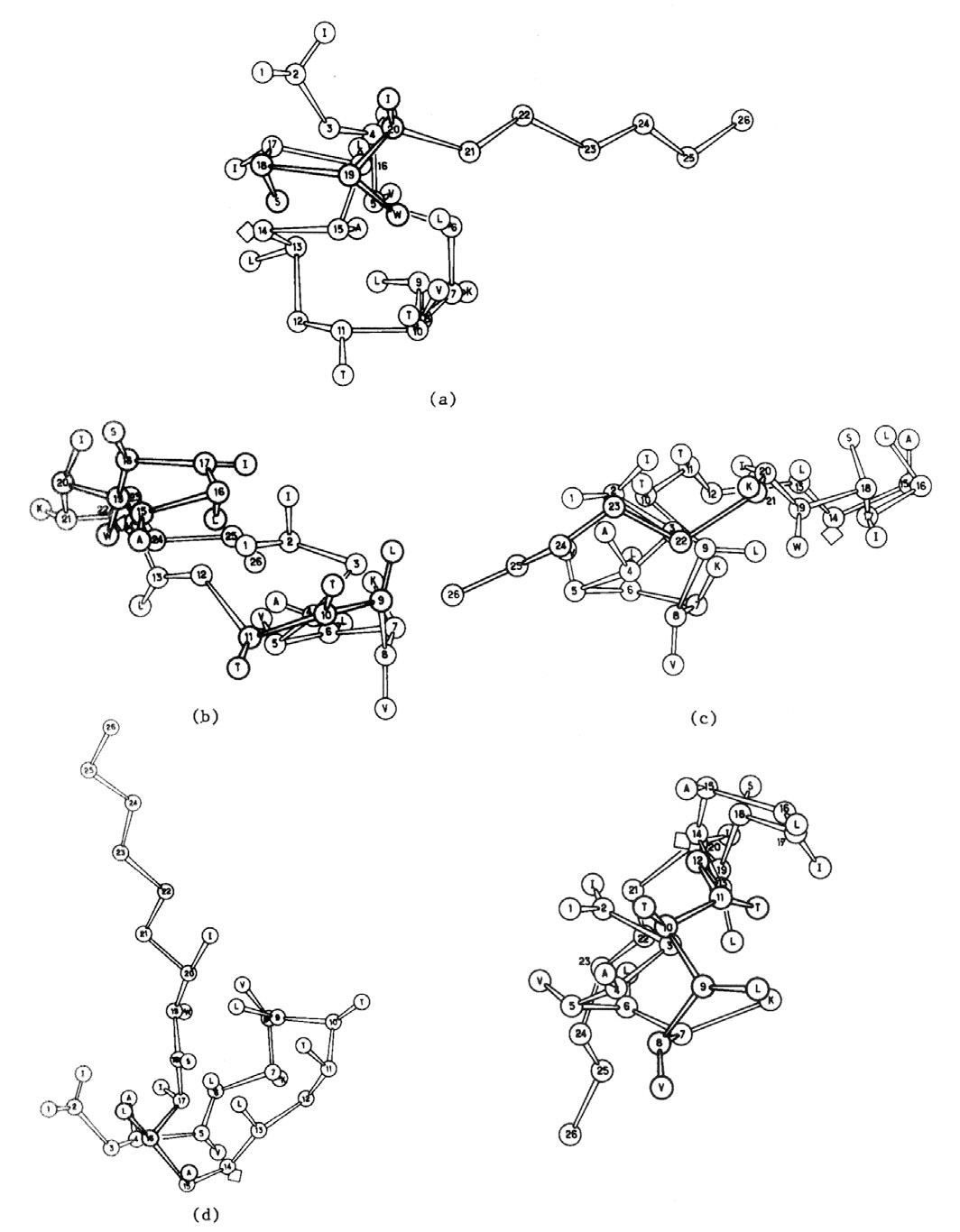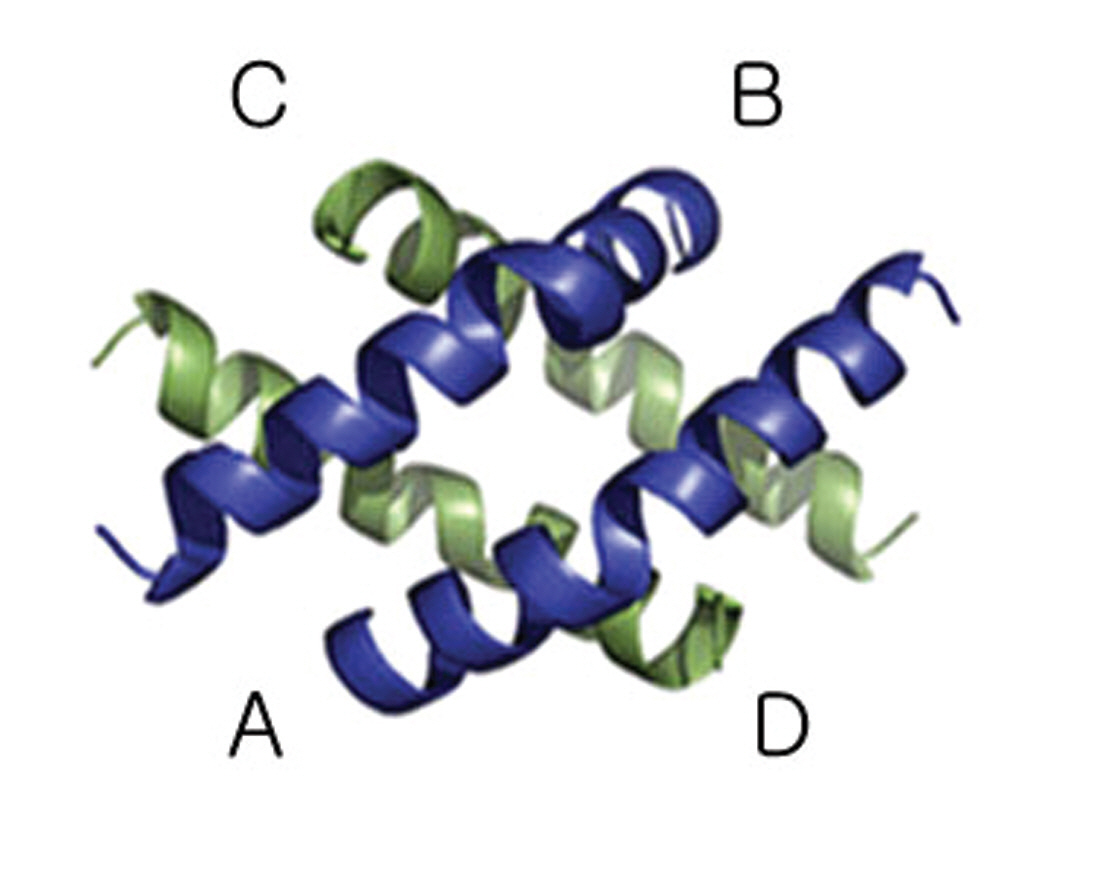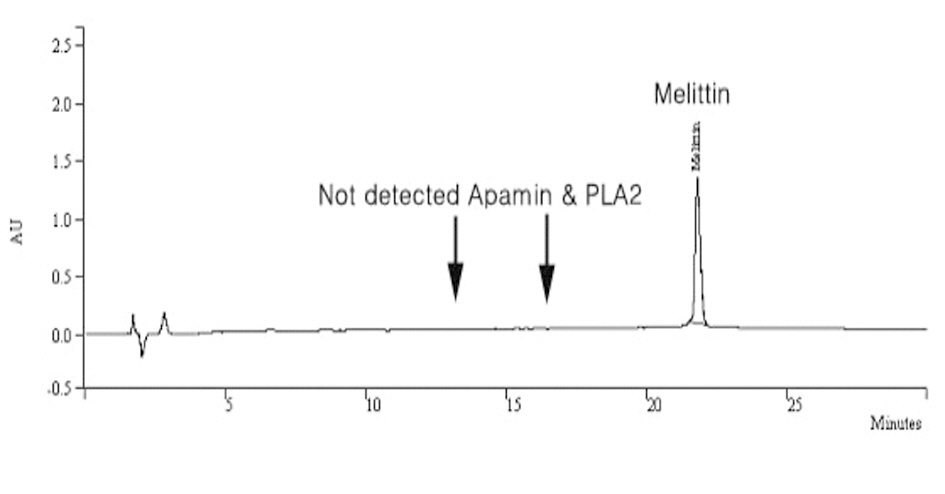



봉약침요법이란 살아 있는 꿀벌(
벌의 독은 진통, 소염 효과2-3)가 우수하고 항암 효과4)가 있음이 보고되었으며 퇴행성 관절염5-7)이나 류마티스 관절염8-9), 추간판 탈출증10-12), 편타 손상 등13-14)에 유효한 것으로 알려져 있다. 하지만 시술 후에 나타나는 알레르기 반응, 즉 시술부위가 붓고 가려우며 시술 시의 통증 유발 등의 국소 알레르기 반응과 벌의 독에 과민한 체질에서 발생하는 전신 알레르기 반응(anaphylactic shock) 등은 임상에서 시술자와 환자들이 본 치료법을 경계하는 주요 원인이 되고 있고, 봉약침요법의 대중화에 가장 큰 걸림돌로 작용하고 있다.
이러한 문제점을 해결하기 위하여 그동안 다양한 연구가 시도되었고, 그 결과로 개발된 것이 Sweet Bee Venom(특허 제 10-0744755, 이하 Sweet BV)이다15). Sweet BV는 건조 봉독에서 약 40-50%를 차지하는 분자량 2840의 순수 melittin으로16), gel filtration이라는 단백질 분리기법을 이용하여 얻고 있다15). 이미 melittin은 소염, 진통, 항암 효과 등이 있음이 많은 연구보고17-18)를 통하여 알려져 있으나 이러한 연구는 대부분 실험실 내에서 melittin의 미량 사용으로 이루어진 결과물로 의료용 치료제제로서의 의미 있는 연구 자료나 산업화의 개념과는 거리가 있었다.
이에 저자는 최근 김 등19)이 “Sweet BV의 rat에 대한 단회 근육시술 독성시험” 을 보고한 연속 연구의 일환으로 식품의약품 안전청의 독성시험기준(식품의약품안전청고시제2005-60호)에 근거하여 비설치류인 비글견을 대상으로 Sweet BV를 근육 시술하여 단회 독성을 평가한 바, 유의한 결과를 얻었기에 보고하는 바이다.
Sweet BV를 전자저울 (LA230S, CP323S, Sartorius, Germany)로 측량하여 조제병에 넣고, 부형제(normal saline)를 일부 넣어 vortex mixer로 용해시키고, 실험에 필요한 농도로 만들어 사용하였다. Sweet BV는 시술 당일에 조제하여 사용하였다.
2.1. 실험동물 및 사육 환경
실험에 사용된 동물은 5∼6개월령의 Beagle 견(Beijing Marshall Biotechonology, China)으로 암·수 각각 3마리씩 입수하여 사용하였다. 입수 시 수컷의 체중은 7.14∼7.54 ㎏이었고, 암컷은 6.79∼6.97 ㎏이었다. 입수 후 14일간의 검역·순화 기간 중 매일 1회씩 일반증상을 관찰하였고, 주 1회 체중을 측정하였으며 검역기간 종료 후에도 건강상태를 확인하였다. 실험실의 온도는19.1∼22.6 °C, 습도는 39.0∼68.3%를 유지하였고, 실험동물용 개 사료(Agribrands Purina, Korea)는 마리당 250 g씩, 물은 충분히 공급하였다. 모든 실험은 식품의약품안전청고시 제2005-79호(비임상시험 관리기준)의 Good Laboratory Practice(이하 GLP) 규정을 준수하여비 임상시험 인증기관인 (주)바이오톡스텍에서 시행하였다.
실험 개시 시 수컷의 체중은 7.99∼8.34 ㎏이었고, 암컷은 7.47∼7.83 ㎏이었다.
2.2. 군의 분리
군 분리는 검역·순화 기간 종료 후 체중을 기초로 하여 암·수 각각 대조군 1마리, Sweet BV 시술군 2마리씩 분리하였다.
2.3. 1회 시술 용량의 설정 및 시술
Sweet BV의 임상적용 예정용량이 약 0.1∼0.4 ㎎/1회 (성인 60 kg 기준시 최대 0.007 ㎎/㎏)인 것을 참조하여 임상적용 예정용량의 약 1300배인 9 ㎎/㎏을 고용량으로 설정하고, 1 및 3 ㎎/㎏을 저용량 및 중간 용량으로 설정하였다. 대조군에는 시험물질 시술군과 동일한 액량의 부형제(normal saline)를 시술하였다. 먼저 모든 실험군의 좌측 대퇴부에 1 ㎎/㎏을 시술한 후 저용량으로 인한변화를 1주일간 관찰하였고, 관찰이 끝난 후 3 ㎎/㎏을 우측 대퇴부에 시술한 후 1주일간 관찰하였으며, 고용량으로 설정된 9 ㎎/㎏을 좌측 대퇴부에 시술한 후 최종 13일까지 매일 체중 측정을, 14일까지 일반 증상을 관찰하였다.
3.1. 일반증상 관찰
시술당일 (0일)에는 시술 후 30분과 1, 2, 4 및 6시간째에 운동성, 자율신경계의 기능 및 배설물 등에 대한 일반증상을 관찰하였다. 시술 후 2일째부터는 1일 2회 관찰하였고, 빈사나 사망동물의 유무를 확인하였으며, 최종 시술후 14일까지 매일 1회 일반증상을 관찰하였다.
3.2. 체중측정
체중은 시술당일 (시술 전), 시술 후 1, 3일째, 그리고 최종 시술 후 1, 3, 7 및 13일에 측정하였다.
3.3. 부검
관찰기간 종료 후, 모든 개체는 마취 하(thiopental sodium,중외제약)에 방혈하여 안락사 시킨 후 부검하였다.
3.4. 조직병리학적 검사
부검을 실시한 대조군 및 실험군의 모든 동물에 대하여 뇌(brain), 간 (liver), 폐(lung), 신장(kidney), 척수 (spi nal cord) 등의 장기와 시술 부위인 대퇴부의 조직을 적출하여 10% 중성완충 포르말린용액 (neutral buffered formalin)에 고정하였다.
고정한 조직은 삭정, 탈수 및 파라핀 포매 등의 일반적인 조직처리과정을 거쳐 조직절편을 제작하여 박절한 후, Hematoxylin & Eosin (H&E) 염색을 실시하였다.
실험군을 암수 각각 2마리로 하여 모든 결과에 대한 통계 처리는 시행하지 않았다.
실험기간 동안, Beagle의 암·수 모두에서 사망 개체는 관찰되지 않았다. 일반증상의 관찰에서 Sweet BV의 저용량인 1.0 ㎎/㎏ 시술 후 실험군 모두에서 약 5-10초간 심각한 통증에 대한 반응을 나타내었고, 그 후 체온의 하강, 경도의 창백, 약간의 보행이상, 그리고 시술 부위의 종창이 관찰되었다(Table 1). 시술 후 약 6시간이 경과하자 종창 이 외의 모든 증상은 소실되었고, 종창은 5일간 지속되었다.
Sweet BV 3 및 9 ㎎/㎏ 시술 후 역시 통증에 대한 예민한 반응과, 보행이상, 그리고 시술 부위의 종창이 관찰되었고, 종창은 5-7일간 지속되었다. 단, 암컷 1례(2202)에서 9 ㎎/㎏ 시술 후 상기한 증상 이외에 활동성의 저하와 구토 증상이 관찰되었다.
부검에서 암·수 모든 실험군에서 Sweet BV 시술 부위인 좌·우 대퇴 근육에 국소성 황색, 혹은 분홍색의 병소(focus, yellowish or pink)가 관찰되었다. 그 외에는 이상 소견이 관찰되지 않았다.
암수 대조군과 비교하여 Sweet BV 시술군에서는 시술부위인 대퇴부의 근육에 근섬유의 괴사(necrosis), 위축성병변(degenerative, atrophic change) 및 재생(regeneration), 염증성 세포 침윤(cell infiltration, inflammatory response), 혈관염(vasculitis), 출혈(hemorrhage), 혈철소 침착(deposit, hemosiderin), 섬유화(fibrosis) 및 지방층염(panniculitis) 등이 관찰되었고 농도 의존적경향을 나타내었다(Fig. 2, Table 3.).
그 외 수컷의 1례에서 폐의 종말세기관지 주위에 국소성 폐포 대식세포 침착(deposit, alveolar macrophage) 소견이 관찰되었다(Fig. 3).
뇌와 간, 폐, 신장, 척수 신경 등 장기나 조직의 이상 유무를 확인하기 위하여 시도된 실험군의 부검 및 조직병리학적 소견을 관찰한 결과 Sweet BV의 시술에 의한 장기나 조직의 이상은 관찰되지 않았다(Fig. 4-8, Table 4.).
毒(poison, toxin, toxicant)이란 “여러 가지 경로를 통해서 소량이 체내로 들어오면, 생체조직에 기능적 혹은 형태적으로 장애를 주거나 혹은 치사작용을 일으키는 물질”로 정의하고 있다20).
한의학에서도 약재에 대하여 有毒, 無毒 등의 표현으로 독성을 분류하여 임상에 사용하고 있고, 본초학의 고서인 神農本草經에서도 독성의 强弱에 따라 上藥, 中藥, 下藥의 세 가지로 나누어 上藥은 거의 無毒하면서 장기간 복용하여 輕身益氣, 不老延年 등의 효능이 있는 약으로, 中藥은 약간의 독성을 지니면서 질병의 예방과 치료에 사용되는 약으로, 그리고 下藥은 독성이 강하여 장기간의 복용이 곤란하면서 질병을 치료하는 효과가 강한 약으로 구분하고 있다21).
어떤 물질에 대한 독성을 평가하기 위해서는 그 물질이 일으킬 수 있는 급성 또는 만성적인 유해 작용과 이들 유해작용 각각의 용량-반응관계를 확인해야 하는데 이러한 정보를 얻는데 가장 중요한 것이 바로 동물을 이용한 시험성적이다. 즉, 독성실험은 의약품 등의 시험물질 안전성 평가를 하기 위하여 중요한 기초자료이며, 필수적이라 할 수 있다22).
독성연구의 주요목적은 신약의 안정성을 평가하여 임상적 용약의 안전을 확보하기 위해 시행하는 것으로, 독성실험은 크게 급성 독성실험(단회투여 독성시험), 아급성 독성실험(;1개월 반복투여 독성시험), 그리고 만성독성실험(;3개월 이상 반복투여 독성시험)으로 나눈다20).
일반적으로 화학적 물질은 그것 자체가 대사물이나 생체부위에 독성 발현을 할 정도의 농도나 충분한 시간에 도달하지 않는 한 유해 작용이나 독작용을 나타내지 않는다. 특이적 화학물질(독성 물질)로 인한 독성 반응은 물질의 물리-화학적 특성이나 노출경로, 생체 또는 사람의 감수성(susceptibility)에 따라 다양한 결과를 나타낼 수 있으므로 독성의 측정은 다방면에서 실시되어야 한다. 특이적 화학물질의 노출 상태에 따라 독성에 영향을 미치는 주요 인자는 투여경로, 시간, 빈도 등이 있다. 노출 경로는 독성 발현에 큰 변화를 나타내는데 생체 내에 노출되는 경로에 따라 정맥 내 > 흡입 > 복강 주사(i.p) > 피하주사(s.c) > 근육 주사(i.m) > 내피(경피) >경구 > 국소(topical)의 순으로 빠르고 강하게 나타나는 경향이 있다.
노출 기간과 빈도도 독성에 영향을 미치는 중요한 인자인데 동물학자들은 동물의 노출을 급성, 아급성, 아만성,만성의 4가지 범주로 나눈다. 급성은 24시간 내의 노출을, 아급성은 1개월 또는 1개월 이내의 노출을, 아만성은 1-3개월 간, 만성 노출은 3개월 이상을 말한다. 노출의 방법도 독의 작용에 차이를 가져올 수 있는데, 이에 따라 단회 투여, 혹은 반복 투여로 나누어 평가한다.
화학물질의 원치 않는 독성효과에 대한 기준을 마련하기 위하여 우리나라에서도 이미 오랜 기간 독성의 성적 수집을 촉진시키는 일련의 시험계획지침서(testing protocol guideline)와 급·만성 도는 특수 독성 시험에 관한 지침이 공포되어 적용되고 있다.
식품의약품 안전청에서도 독성시험기준23)을 엄격하게 제안하고 있고, 이러한 시험은 모두 GLP 규정에 의해 평가되어야 인정을 받을 수 있다. 또한 의약품의 품목 허가신고·심사 규정24)에서도 의약품의 안전성·유효성 심사를 위하여 제출해야 하는 자료로 첫째, 기원 및 발견의 경위(배합목적 및 용도에 관한 자료 포함), 둘째, 물리화학적 성질, 규격에 관한 자료, 셋째, 안정성에 관한 자료, 넷째, 독성에 관한 자료(보존제 및 타르색소의 경우에는 신약의 첨부자료에 준하며 그 외에는 단회투여독성, 반복투여독성, 기타 필요한 독성시험자료)를 제출해야 한다고 규정하고 있다.
봉약침의 원료인 봉독의 주요 성분은 크게 효소, 펩티드, 저분자 유기물질로 나눌 수 있고 현재까지 약 40여개의 물질이 보고되고 있다16). 봉약침은 살아있는 꿀벌(서양종 일벌-Apis mellifera) 독낭에서 봉독을 추출, 가공하여 약침제제로 만든 후, 변증을 통하여 선정된 혈위에 적정량 주입함으로써 침 자극과 봉독의 약리학적 자극을 동시에 응용하는1) 전문적 침구의학의 한 분야이다.
그동안의 연구 보고에 의하면 봉약침은 진통 소염효과2-3)가 있고, 면역계에 작용하며8-9, 17-18) 이미 많은 임상 보고를 통하여 퇴행성 슬관절염5-6)이나 고관절염7), 류마티스 관절염8-9), 요추간판 탈출증10-12), 중풍 후유증13-14)등의 질환이나 다발성 경화증25), 근위축성 측삭경화증26), 그리고 근이영양증27)과 같은 난치성 질환에도 유의한 치료효과가 있음이 보고되고 있다.
그러나 대부분의 독과 같이 벌의 독에 노출되었을 때도 과민한 면역반응이 나타날 수 있고, 특히 치명적인 아낙필락시 반응은 봉약침의 임상 사용에 중요한 걸림돌이 되고 있어28-30) 이러한 문제를 개선하고자 봉약침의 항원역할을 하는 효소인 phospholipase A2(이하 PLA2)나 hyaluro nidase 등의 고분자 물질과 histamine 등의 저분자 물질을 함께 제거하고, 벌의 독에서 가장 주된 성분인 melittin만을 분리 정제한 Sweet BV가 개발되었고15), 선행 연구를 통하여 봉약침에 의한 아나필락시 반응의 위험과 국소알레르기 반응을 낮출 수 있음이 보고31-33)된 바 있다.
Melittin은 26개의 아미노산으로 구성된 peptide로 벌의 독에서 건조 중량 40-50%를 차지하는 분자량 2840의수용성 물질이다16)(Fig. 9). Melittin은 벌의 독에서 가장 중요한 allergen인 PLA2를 활성화시키고 세포막에 구멍을 뚫어 파괴시키는 작용이 있는 것으로 알려져 있는데 이러한 작용은 melittin의 구조(Fig. 10)와 관련이 있는 것으로 알려져 있다34). 각각의 사슬은 두 개의 나선구조로 되어 있고, 모두 휘어진 막대기 모양을 하고 있다. 이러한 구조는 세포의 용해 작용이 용이하고, 따라서 melittin이 암세포의 사멸이나 소염효과를 나타내는 것과 밀접한 관련이 있는 것으로 추정된다.
이미 이전의 보고18, 31)에서 melittin은 nuclear factor-κB(이하 NF-κB)의 활성을 조절하여 lipopolysaccharide(LPS), tumor necrosis factor-α(TNF-α), 그리고 sodium nitroprusside(SNP)의 활성을 저해하여 염증의 활성을 억제하는 것으로 알려져 있다.
NF-κB는 면역과 염증에 관여하는 많은 유전자들을 조절하는 인자이며 세포자멸사를 억제하는 것으로 알려져 있다33). NF-κB군에는 NF-κB1(p50), NF-κB2(p52), Rel 단백인 RelA(p65), RelB, c-Rel 등이 있는데 NF-κB p50은 암세포의 발현에서 가장 빈번하게 발현되는 단백으로 특히 대장, 직장암의 발생과정에서 증가하는 것으로 알려져 있으며34) 암의 진행에 중요하게 작용하는 단백질이다. Melittin은 NF-κB p50의 활성을 저해하고 이를 통해 류마티스 관절염과 같은 염증성 질환을 억제하는 것으로 보고되고 있다35).
독성의 정도를 평가하는데 반수치사량(이하 LD50)은 중요한 지표가 된다. 이전에 권 등36)이 보고한 바에 따르면 Sweet BV는 벌의 독에서 PLA2나 hyaluronidase 등과 같은 효소(고분자 물질)만을 제거하였을 때 시술부위별 LD50은 15-20 ㎎/㎏에 분포하였다. 하지만 histamine등의 저분자 물질을 효소와 함께 제거하고 나서 진행한 실험19)에서는 1회에 30 ㎎/㎏을 시술하였을 때에도 단 한 개체의 사망이 발견되지 않아 Sweet BV의 LD50은 30 ㎎/㎏을 훨씬 상회하는, 즉 독성이 많이 약화된 것으로 추정되었다(Fig. 11).
본 연구에서는 이전의 결과19)를 바탕으로 Sweet BV의 단회 독성을 비설치류인 비글견 암·수 각각 3마리를 대조군과 실험군으로 나누어 1.0 ㎎/㎏, 3.0 ㎎/㎏ 및 9.0 ㎎/㎏의 저, 중, 고용량으로 구분하여 단회 근육부위에 시술시 나타나는 독성반응을 관찰하고자 하였다. Rat를 이용한 Sweet BV의 단회 독성시험에서 LD50이 30 ㎎/㎏을 훨씬 상회하는 것으로 나타났고, 본 연구에서는 시술 시에 나타나는 일반적인 증상의 관찰이 주목적이므로 저용량은 비글견의 좌측 대퇴부에, 중용량은 우측 대퇴부에, 그리고 고용량은 다시 좌측 대퇴부에 시술하였다.
실제 임상에서 환자에게 사용하는 용량에 비하여 본 연구에서 고용량군으로 설정한 9.0 ㎎/㎏은 체중 대비 약 1,300배에 해당하는 엄청난 양이고 한 마리당 3주간 시술한 총량이 14.0 ㎎/㎏ 임에도 불구하고 모든 실험군에서 사망하거나 심각한 부작용을 호소한 개체는 관찰되지 않았다.
일반증상의 관찰에서 Sweet BV의 저용량인 1.0 ㎎/㎏ 시술 후 실험군 모두에서 약 5-10초간 심각한 통증에 대한 반응을 나타내었고, 그 후 체온의 하강, 경도의 창백, 약간의 보행이상, 그리고 시술 부위의 종창이 관찰되었다. 시술 후 약 6시간이 경과하자 종창 이 외의 모든 증상은 소실되었고, 종창은 5일간 지속되었다.
Sweet BV 3 및 9 ㎎/㎏ 시술 후 역시 통증에 대한 예민한 반응과, 보행이상, 그리고 시술 부위의 종창이 관찰되었고, 종창은 5-7일간 지속되었다. 단, 암컷 1례(2202)에서 9 ㎎/㎏ 시술 후 상기한 증상 이외에 활동성의 저하와 구토 증상이 관찰되었는데 이는 인체에서 나타나는 과민반응과 유사하였다.
관찰기간 동안 실험군 암·수 모두에서 대조군과의 유의한 체중 차이는 나타나지 않았다. 다만 암컷 실험군에서 대조군에 비하여 시간이 경과할수록 체중이 증가하는 경향을 나타낸 것이 이전의 연구 보고19)와 차이점이었다(Fig.1, Table 2.).
실험 종료 후 비글견을 치사하고 부검을 시행한 결과 암·수 모든 실험군에서 Sweet BV 시술 부위인 좌·우대퇴 근육에 국소성 황색, 혹은 분홍색의 병소(focus, yellowish or pink)가 관찰되었다. 이러한 현상은 Sweet BV 시술로 인한 국소적인 염증과 종창, 그리고 출혈 반응으로 인한 것으로 추정되었다.
시술 부위인 대퇴부의 근육과 뇌와 간, 폐, 신장, 척수 신경 등 장기나 조직의 이상 유무를 확인하기 위하여 H-E staining하여 조직 병리적 관찰을 시도하였다. 그 결과 대퇴부의 근육에서는 암수 대조군과 비교하여 Sweet BV시술군에서 근섬유의 괴사(necrosis), 위축성 병변(degene rative, atrophic change) 및 재생(regeneration), 염증성 세포 침윤(cell infiltration, inflammatory response), 혈관염(vasculitis), 출혈(hemorrhage), 혈철소 침착(deposit, hemosiderin), 섬유화(fibrosis) 및 지방층염(panniculitis) 등이 관찰되었다. 이러한 반응은 melittin의 세포파괴 작용과 관련이 있는 것으로 추정되었다(Fig.2, Table 3.).
그 외에 뇌와 간, 폐, 신장, 척수 등의 장기조직에 대한 관찰에서는 Sweet BV의 시술에 의한 장기나 조직의 이상 유무는 인정되지 않았다(Fig. 4-8, Table 4.).
단, 수컷의 1례(1202)에서 폐의 종말세기관지 주위에 국소성 폐포 대식세포 침착(deposit, alveolar macroph age) 소견이 관찰되었는데(Fig. 3), 그 정도가 경미하고 다른 사례에서 이와 같은 반응이 관찰되지 않아 개체 차이에 의해 나타난 우발 소견으로 추정되었고, Sweet BV 시술로 인한 것은 아닌 것으로 추정되었다.
이상의 연구 결과 Sweet BV는 과량 주입할 때에 시술부위를 중심으로 국소적인 근육 조직의 염증과 파괴, 그리고 이로 인한 섬유화를 발생시킬 수 있으며 장기나 조직에는 특별한 이상을 유발하지 않는 것으로 판단되었다.
본 연구는 벌의 독에서 추출한 Sweet BV(melittin)의 비설치류(비글견)에 대한 단회 독성을 평가하고자 식품의 약품안전청고시의 Good Laboratory Practice (GLP)규정을 준수하여 시도하였다. 그 결과 다음과 같은 결론을 얻었다.
1. 모든 실험군에서 사망한 개체가 관찰되지 않았다.
2. 시술 후 일반증상의 관찰에서 1 ㎎/㎏ 이상을 시술하였을 때 실험군은 대조군에 비하여 시술 시에 심한 통증을 호소하였다. 또한 시술 부위를 중심으로 충혈, 부종 또는 보행이상 등이 관찰되었고, 부종을 제외한 제반 증상은 6시간 가량 지속되었으며, 시간이 흐를수록 반응은 약해졌다. 시술 부위의 부종은 약 5일간 지속되었다. 전신 증상은 약간의 체온저하와 경도의 창백이 나타났으며 심각한 반응은 아니었다.
3. 체중의 변화를 측정한 결과 암·수 모두에서 대조군과 유의한 차이를 나타내지 않았다.
4. 장기와 조직의 이상 유무를 확인하기 위하여 실험 종료 후 시술 부위의 근육과 뇌, 간, 폐, 신장, 그리고 척수신경 등을 적출하여 H-E staining을 이용한 조직학적 관찰을 시도한 결과 시술 부위의 대퇴부의 근육에서는 근섬유의 괴사, 위축성 병변 및 재생, 염증성 세포 침윤, 혈관염, 출혈 등이 관찰되었다. 기타 장기와 조직에는 이상 소견이 관찰되지 않았다.
5. Sweet BV의 비글견에 대한 최대내성용량은 9 ㎎/㎏을 휠씬 상회하는 것으로 판단되었다.
이상의 연구 결과를 바탕으로 Sweet BV는 약침으로 임상에 사용하기에 안전한 치료제임을 알 수 있었다. 향후 이에 대한 보다 다양한 연구가 진행되어야 할 것으로 사려된다.
[Table 1] Clinical signs in dose-escalationg single intramuscular toxicity study of Beagle dogs
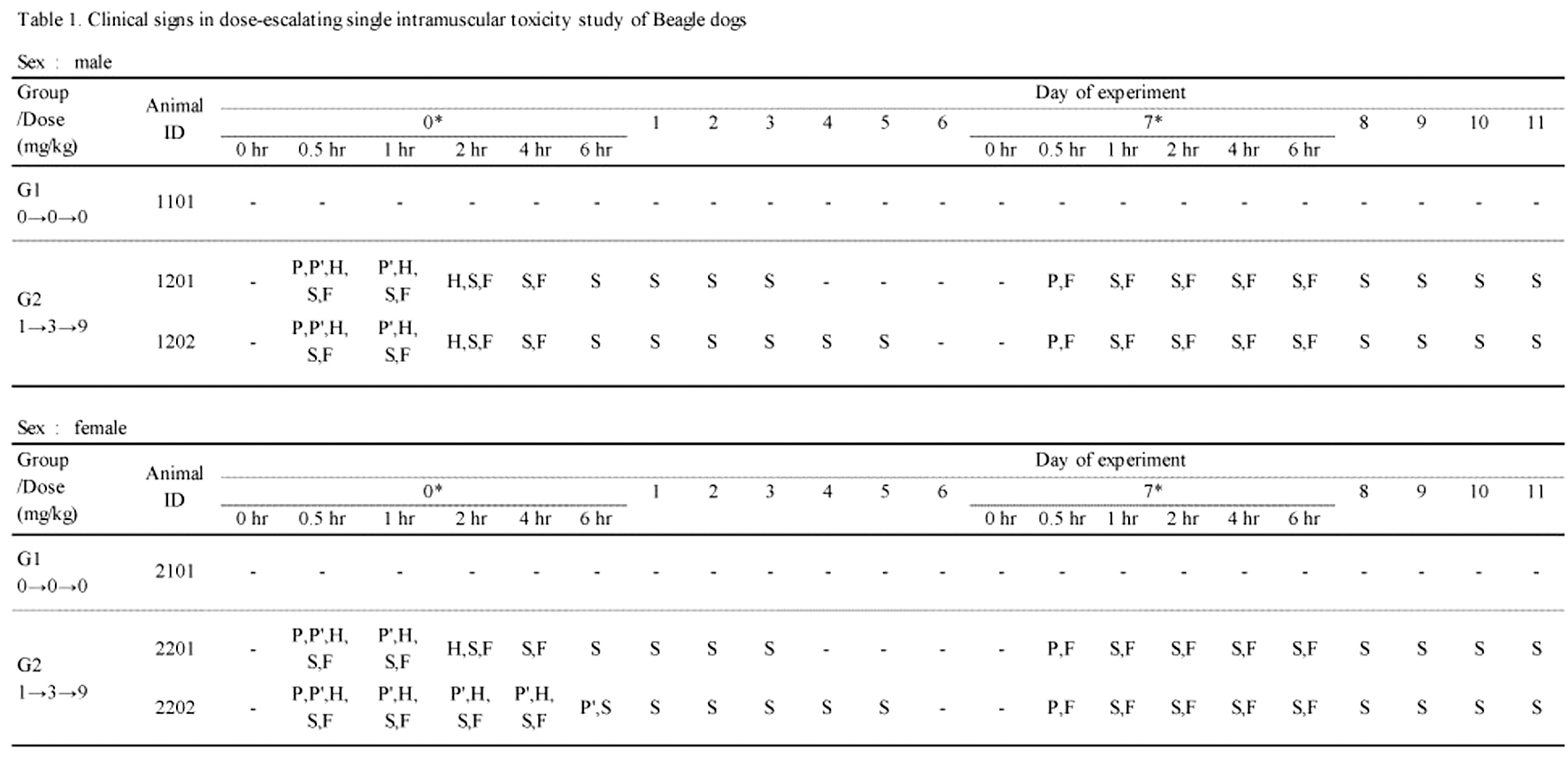
Clinical signs in dose-escalationg single intramuscular toxicity study of Beagle dogs
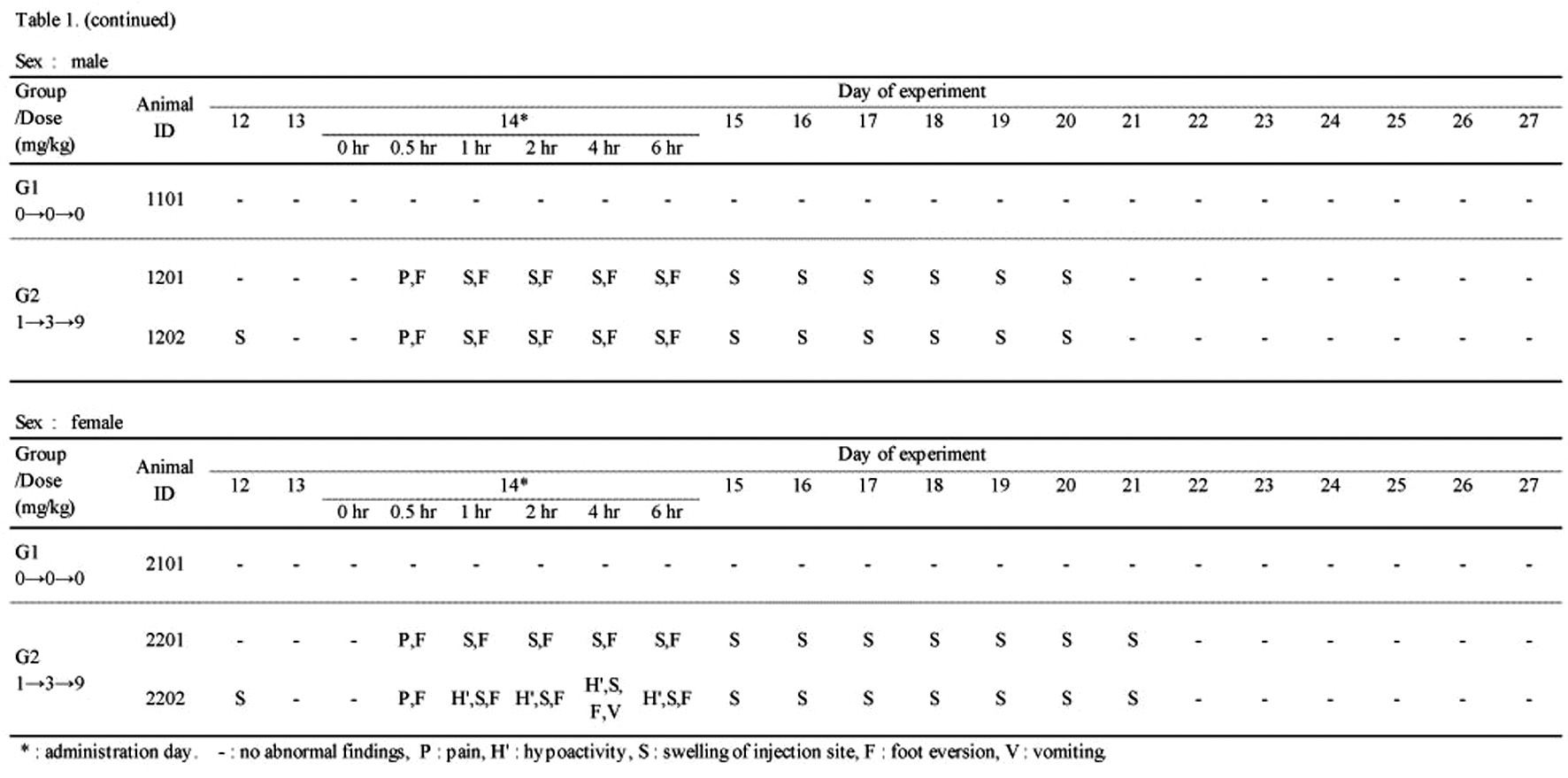
(continued)
[Table 2] Body weight changes in dose-escalating single intramuscular toxicity study Beagle dogs
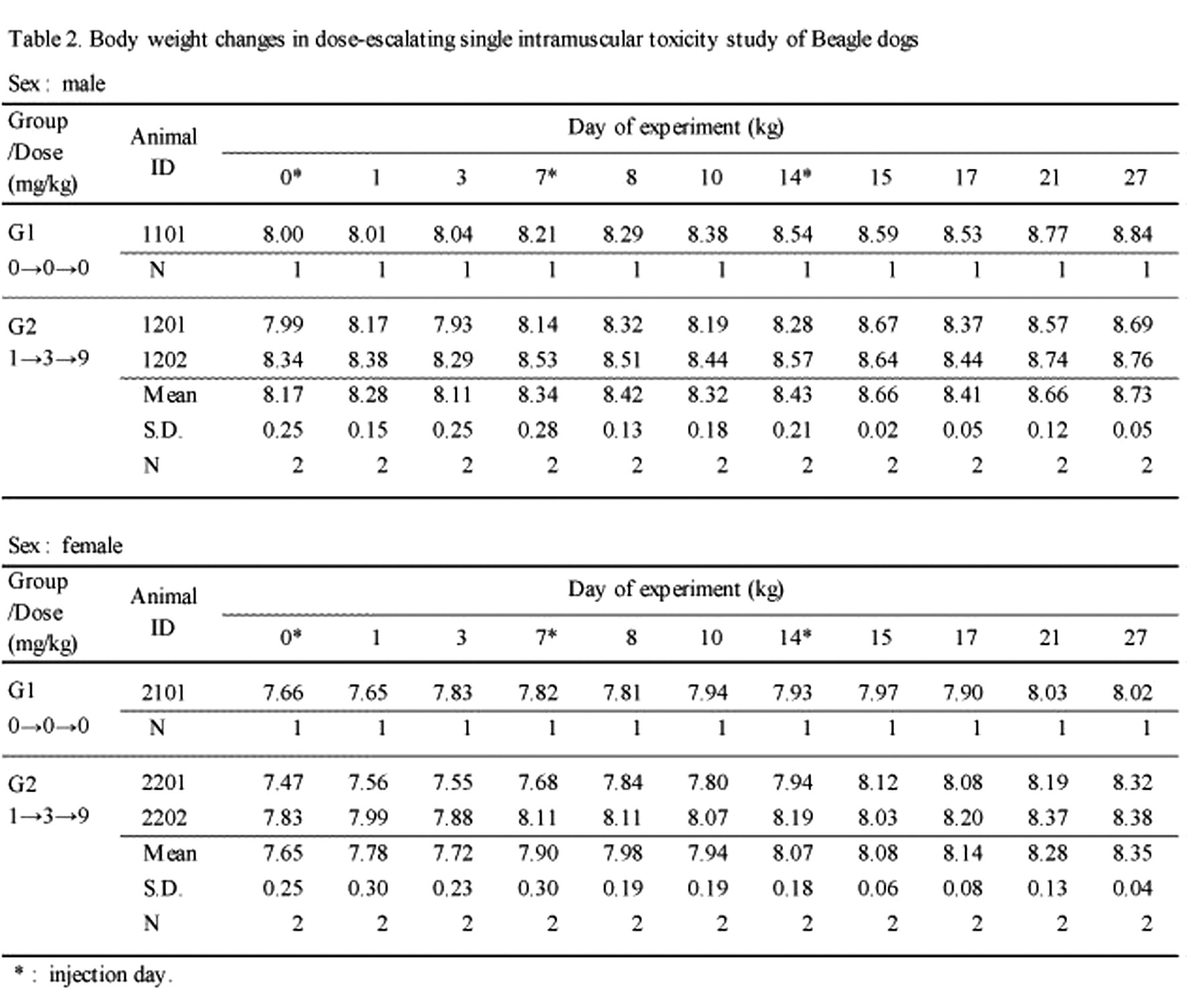
Body weight changes in dose-escalating single intramuscular toxicity study Beagle dogs
[Table 2-1] Body weight changes in dose-escalating single intramuscular toxicity study Beagle dogs
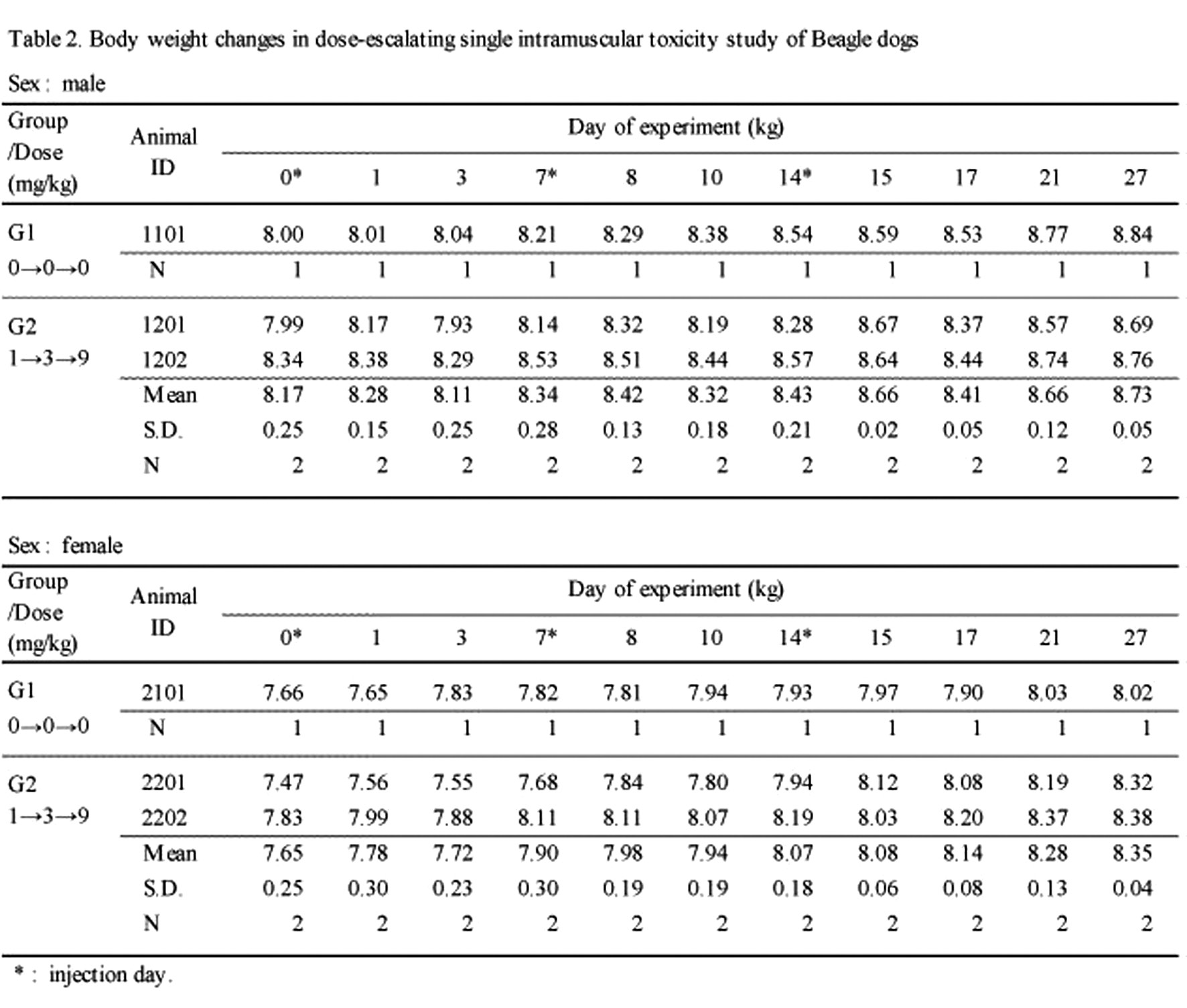
Body weight changes in dose-escalating single intramuscular toxicity study Beagle dogs
[Table 3.] Necropsy findings in dose-escalating single intramuscular toxicity study of Beagle dogs
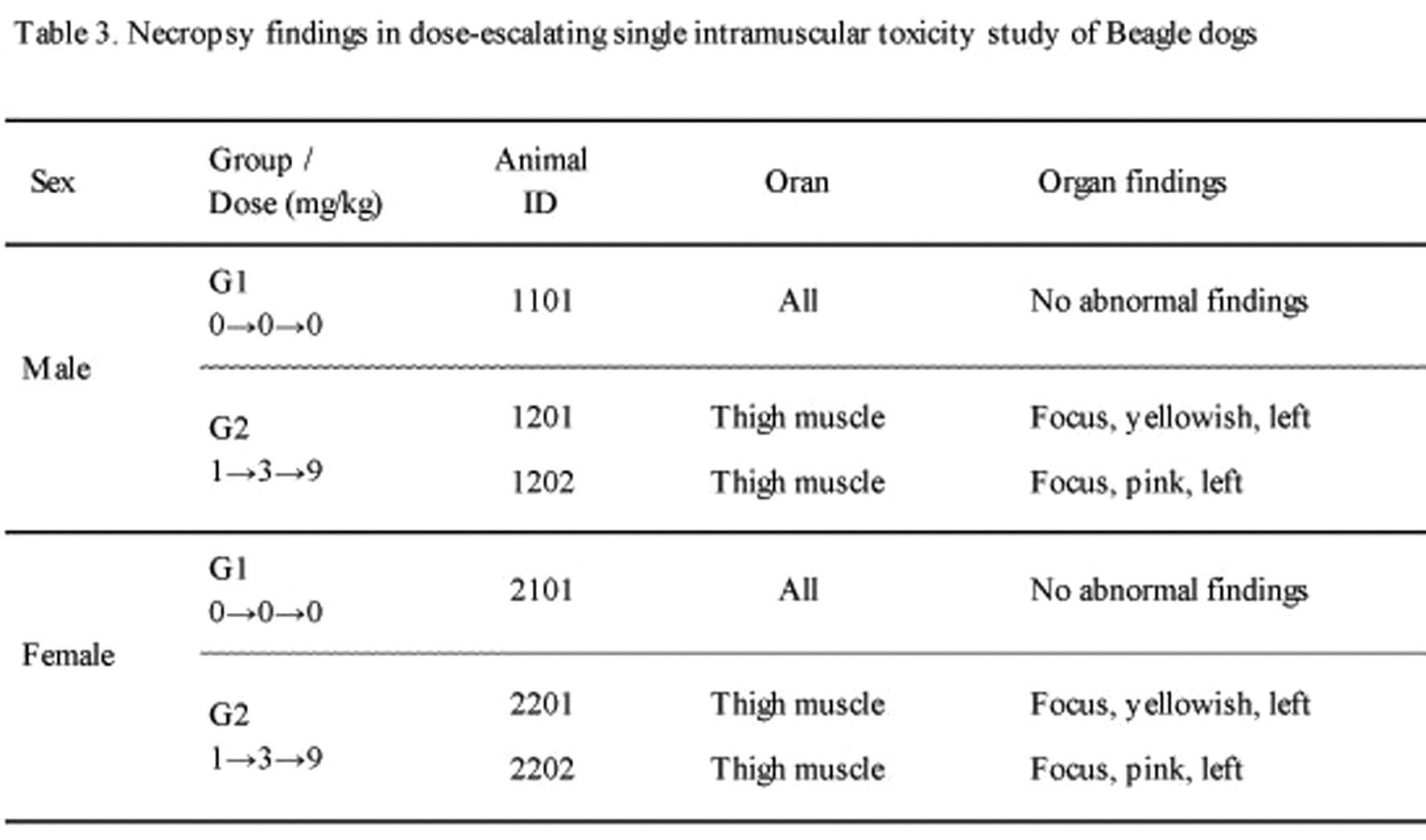
Necropsy findings in dose-escalating single intramuscular toxicity study of Beagle dogs
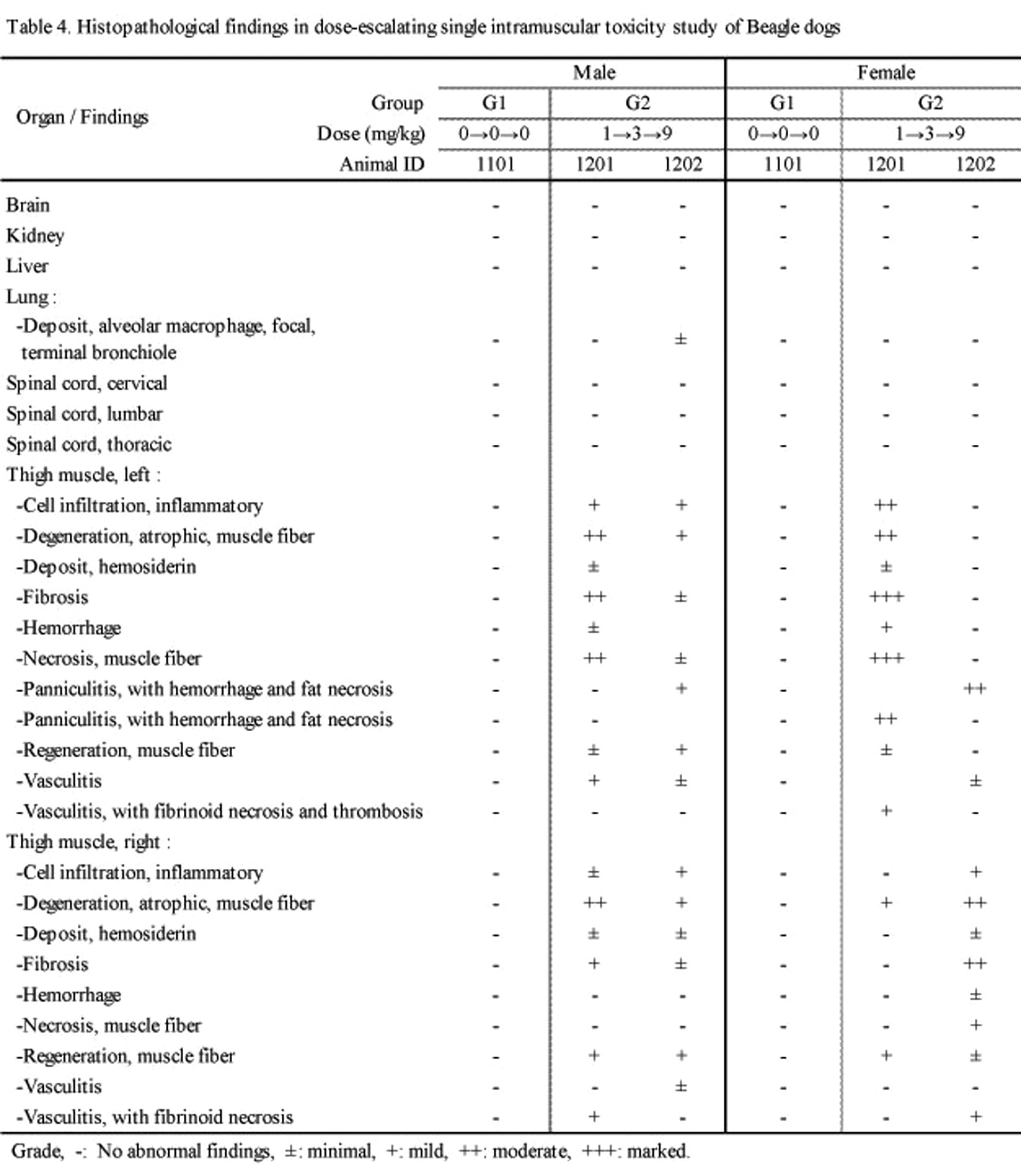
Histopathological finding in dose-escalating single intramuscular toxicity study of Beagle dogs


